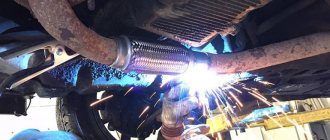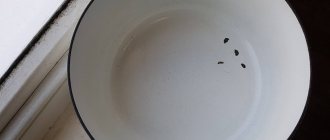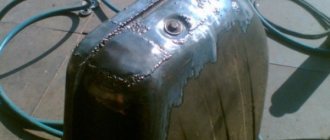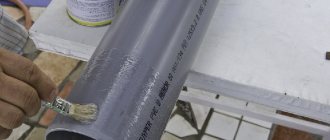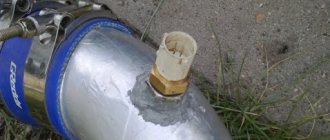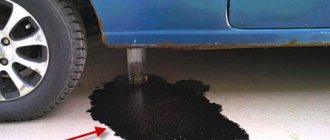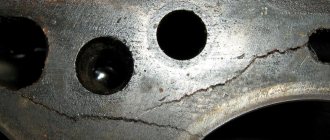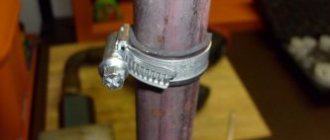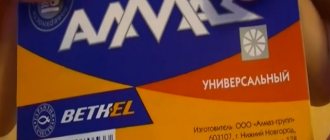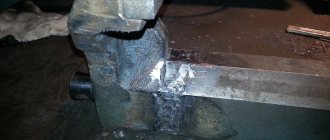The muffler is an integral part of the vehicle's exhaust system; its task is to accept the mixture entering through the pipe, reduce its intensity and feed it into the exhaust pipe. Due to its specific functions and lower location, the part is subject to rapid wear, which is caused by:
- high internal pressure and temperature during operation;
- chemical activity of individual components of exhaust gases;
- vibrations when driving, friction and impacts on the road surface.
From this it is easy to conclude that the most common damage to the muffler is burns and cracks.
Both problems become worse as the metal gradually thins out. The same factor makes it difficult to repair mufflers using classical welding methods, because even under the most gentle operating conditions, an electric arc or gas flame will almost certainly not eliminate the damage, but will deform the metal or burn new “holes.”
Looking for a reason
What affects the premature failure of muffler pipes:
- The temperature regime of the exhaust gases at the entrance to the receiving pipes of the manifold, called pants by car owners, is close to 10,000 C;
- Poor quality fuel and consequences: products of incomplete combustion;
- Moisture condensation;
- External mechanical damage.
An inspection with the engine off on an overpass usually gives immediate results. Deviations in color, traces of drips are a signal for a scrupulous search for the hole. Dismantling and thorough inspection of the surface of the muffler and pipes will make it possible to prevent catastrophic destruction of the integrity of the metal and corrugations.
If the area of the hole does not exceed the size of a pin head, we can safely undertake the repair on our own . A hole larger than a coin or a longitudinal crack will require more attention.
But there are no barriers for a craftsman. And we can cope with this problem by strengthening cold welding with a substrate. A hole in the exhaust manifold pipe requires immediate action while it is small. We missed it - we’ll still manage without a car service.
How to choose cold welding
The variety of pasta choices makes buyers think about the right choice. Therefore, when choosing a composition, several points are taken into account:
- The maximum temperature that the seam will withstand. Since the muffler is constantly exposed to temperatures. The adhesive must withstand significantly higher temperature barriers. If the packaging indicates a temperature close to the temperature of the metal to which it is applied, then this product is not purchased.
- The composition includes a metal filler, which provides adhesion to metal.
- After drying, the material withstands mechanical damage and loads to which the exhaust structure is constantly exposed from the outside.
An example of such a structure is the welding of Abro Steel . Produced in the United States. This is where high-quality compounds are produced. It is used on various surfaces and provides high adhesion to any surface. The composition includes epoxy resins, which means that the mixture can withstand temperatures up to 204 degrees. The structure does not blur or change when interacting with liquids and oils. Adhesion is achieved after one hour, complete drying occurs after 24 hours.
Titan cold glue . It is sold in two containers in a single package. Before use, mix in proportions strictly according to instructions. The containers are presented in jars with lids, which is convenient for further storage. There is also a white Titanium mixture available, which comes in the form of a rod.
Withstands high temperatures over 200 degrees. Strength is achieved quickly. Once mixed, the mixture is used within five minutes. The first drying lasts 20 hours, the final drying after 24 hours.
Application
Adhesive sealants or cold welding based on epoxy resins are suitable for eliminating gas tank leaks and restoring the radiator . There is also a solution for a hot muffler that is not afraid of temperature aggression.
Species composition:
- one-component formulations, ready for use after kneading;
- two-component liquid formulations;
- two-component plasticine-like;
- high temperature compounds.
Important! heat-resistant adhesives can withstand heat loads of 200–14000 C; increasing the temperature during the polymerization period strengthens the mixture.
Adhesive compounds recommended for restoring the exhaust system tolerate vibration, shock loads and stress without consequences. They have diffusion adhesion to steel and cast iron.
Precautionary measures due to the toxicity of the compounds:
- Natural ventilation of the room;
- Work should be carried out with rubber gloves;
- Mix the components in a non-metallic non-food container;
- In case of contact with skin, wash off with soap.
Repair with ceramic tape
Ceramic tape is an equally easy repair method. It can withstand temperature loads of up to 1000 degrees Celsius thanks to its ceramic base. Tape won't help when changing whole parts, but it will help to fix a problem with a small hole or gap.
It is easy to use ceramic tape:
- Clean the muffler before repairing.
- Wet the tape with water.
- Wrap at least 2 layers around the damaged area.
Repairing a muffler using a ceramic tape bandage
Ceramic tape is still a temporary option and will last up to three months. It will not be possible to solve the problem completely with its help, so it is only suitable as an emergency measure.
Choice
We recommend the brand of cold welding for the car muffler DONE DEAL thermal steel 1400 C. The digital designation indicates the permissible temperature. Components: sodium silicate, synthetic fibers. The strength of the connection is given by the metal filler .
Titanium will withstand heating up to 3000 C without damage. It is supplied in 2 types: with a kneading rod and separately - hardener and glue in different jars. According to reviews, the advantages prevail. Worth keeping in stock.
Abro Steel is inferior in temperature indicators. The collector will not withstand thermal shock. It will work on the muffler. It can withstand dynamic loads, but with difficulty. Not afraid of water and aggressive liquids. Do not heat until complete polymerization.
The initial setting of cold welding takes 5–20 minutes . The exact numbers are in the instructions. Corrections to the form and filling are allowed until the drying period of the surface layer has expired. After 24 hours, the sealant can be machined.
Removing excess or damaged sealant with solvents is not always effective. An alternative is mechanical cutting with a chisel, filing with a file, or with a power tool.
Strength is an undoubted advantage: cold welding for a car muffler can withstand machining and drilling without damage, and will retain threaded grooves after the tap.
Advantages of using cold welding to repair a muffler
Repair by cold welding is an excellent way to eliminate defects in exhaust structures; in addition, the part acquires additional qualities.
This material is a two-component adhesive that is used for metal surfaces. A number of advantages in use:
- Withstands mechanical, shock and vibration loads.
- Resistant to elevated temperatures (up to 150 degrees).
- Easy to use, allowing you to seal it yourself without using welding equipment.
- Availability.
- The strength of the connection is achieved in 5–10 minutes.
The subtleties of repairing a car silencer: is it possible to cover up or seal the hole?
If it is not possible to order sandblasting of the muffler and pipes, the places where gases escape are cleaned with coarse sandpaper or a metal brush with a margin of area.
We recommend checking problem areas with active rusting.
The repair area is degreased with a solvent.
Repairing small cracks and holes:
- Longitudinal cracks are drilled along the edges with a Ø 3 drill to relieve internal stress in the metal.
- Mixing of the composition is carried out immediately before sealing.
- Damage up to Ø10 should be covered with a layer of 5–7 mm, supported by 8 mm of whole metal around the perimeter.
- Leave for 4 hours, gradually warm up the unit to operating temperature.
- Bubbling of the adhesive layer indicates a violation of the surface preparation technology. Requires repeated cleaning, degreasing, drying and gluing.
- It is recommended to screw a self-tapping screw into the small holes of the outlet manifold through the cold welding layer.
- The patches of the units under pressure are fixed with clamps to ensure mechanical strength.
How to repair a muffler using bandage tape
Let's move on to how to properly use tape to repair a muffler.
- Step 1 . Prepare the muffler for use. It must be at room temperature - it is unacceptable to work with hot parts! Using a wire brush or other abrasive device, remove dirt, paint residues and burns. Degrease the surface.
- Step 2 . Prepare the bandage tape for use. If it is made on a silicate basis, open the package and pour water inside. Wait a few minutes, shaking the contents occasionally.
- Step 3 . Apply the bandage to the problem area . Wrap it tightly, as if you were looking at a regular elastic bandage. Additionally, secure with the wire that comes with the kit or another wire that you have on hand. Apply the tape overlapping, layer by layer. Start winding not from the damaged area, but with a margin of 1-2 cm. For high-quality repairs, eight to ten layers of tape are enough.
- Step 4 . Wait for the adhesive layer to harden - this will take a maximum of 45 minutes. Constantly level the tape all this time - this way the result will be much better. It takes one day for complete polymerization.
If you are using a sodium silicate bandage and only one part needs to be repaired, use the package at a time - it does not last long. Work in a warm (temperature 14–22 °C) well-ventilated area, use gloves as personal protective equipment.
Some manufacturers sell the tape complete with pastes and resins. They help speed up the hardening of the adhesive layer and improve sealing performance.
Follow the listed steps and our recommendations exactly - this will help you end up with a repaired muffler or other product that needs urgent restoration. But remember that this type of “reanimation” does not eliminate the need to replace the muffler in the future.
Muffler repair
Restoring large-scale damage
Burnt-out sections of the muffler are restored by applying stainless steel patches with an overlap of 30 mm onto undamaged metal. The linings are drilled to the Ø of the self-tapping screw body. Sequence of operations:
- Remove burrs, shape the muffler, clean the trim from the inside, treat with solvent, and dry.
- Apply sealant to the edges of the holes and patches with excess.
- Fasten the screws, add a drop of cold welding under the caps, and tighten the screws.
Elimination of pipe burnout:
- The burnt area is cut out and removed, replaced with a larger diameter pipe.
- Prepare the surfaces, drill the overhead pipe for self-tapping screws on both sides.
- Apply cold welding to adjacent areas and connect.
- Secure evenly with self-tapping screws to seal the pipe caps and joints.
Features of repair of heat exchangers and heat-resistant pipes under pressure:
- Preparation of the repair site.
- Cut and bend the stainless steel plate along the diameter of the pipe with an overlap of 20 mm.
- The composition is applied to both parts.
- Secure the cover with tension clamps.
- It is recommended to reinforce small cracks with a dense steel wire bandage over glue.
What are the criteria for choosing a muffler sealant?
Despite all the variety of car muffler sealants available in stores, you shouldn’t buy the first one you see! First you need to carefully read its description, and only then make a purchasing decision. So, when choosing a sealant, you need to pay attention to the following factors.
Temperature operating range
This is one of the most important indicators. Theoretically, the higher the maximum permissible operating temperature, the better. This means that the sealant, even with prolonged use and high temperatures, will not lose its properties for a long time. However, in reality this is not entirely true. Many manufacturers deliberately mislead consumers by indicating the maximum permissible temperature that the sealant can cope with only for a short time. Naturally, this value will be higher. Therefore, you need to look not only at the maximum permissible temperature value, but also at the time that the sealant is designed at this temperature.
State of aggregation
In particular, heat-resistant muffler and exhaust pipe sealants are divided into silicone and ceramic.
silicone sealant remains slightly mobile, and does not lose its properties during vibration or small shifts of the processed parts. These are used on gaskets when connecting exhaust system elements.
Ceramic sealants (also called pastes or cements) become completely immobile (stone-like) after hardening. This is why it is used to cover up cracks or rusted holes. Accordingly, when vibrations occur, they can crack.
There are always small shifts and vibrations between the elements of a car's exhaust system. Moreover, even when driving, the car constantly vibrates on its own. Accordingly, it is advisable to use a silicone-based muffler sealant paste. Cement for a muffler is only suitable for directly processing the body of the muffler itself.
Sealant type
Sealing materials used to repair exhaust system elements are divided into several types, differing in their performance characteristics.
- Exhaust system repair adhesive . Such compounds are intended for sealing small holes and/or cracks in the exhaust pipe and other parts. As a rule, it is created on the basis of glass fiber and additional additives. It differs in that it hardens quickly (in about 10 minutes). It is resistant to thermal loads, but can also crack under strong mechanical loads.
- Mounting paste . Typically used for machining flange and hose connections. As a rule, it is used when installing new parts or when repairing and installing repaired ones. When exposed to high temperatures, it hardens quickly and retains its properties for a long time.
- Muffler sealant . This is one of the most common options. It is made on the basis of silicone with thermal additives. Can be used both as a preventive and repair agent. Silicone sealant can be used directly in the muffler, pipes, resonator, exhaust manifold. Doesn't freeze right away.
- Cement for muffler . These compounds have very high hardness and can withstand the highest temperatures. However, they can be used to repair only fixed parts - muffler housings, resonator, as well as for processing joints. Cement dries very quickly when exposed to high temperatures.
What is a muffler for?
When designing the engine and other parts of the future car, a huge number of factors and indicators are taken into account. The main functions of the muffler are to reduce the noise level from a running engine and maintain the operating pressure of gases in the system. It wasn't called a muffler for nothing.
If there are cracks in the muffler, firstly, there may be a decrease in exhaust gas pressure, loss of engine power, and the car will “drive worse.” Of course, this applies to older cars that are not equipped with a catalyst. And secondly, the noise increases sharply, up to a level that makes it impossible to operate the car. The exhaust, as they say, is a secret, and this is even worse than without a muffler at all.
Why is it worth repairing rather than replacing immediately? In many modern cars, the muffler is a rather expensive part. Besides the cost, the obvious disadvantage of this route is the replacement time. The part is not changed often, and, therefore, the likelihood of its availability in a warehouse, store or service center is quite low. In most cases, the muffler does not fail as a whole, but only requires repair of individual parts.
In addition, it makes sense to repair the muffler because modern parts are not of high quality. In most cases, a new one lasts for one and a half to two years at best.
Welding work
The most durable and reliable way to repair a muffler is by welding. You can also do welding repairs yourself.
It is worth taking on such work only if you have special welding equipment and a certain skill in welding thin-sheet materials.
The repair technology most often comes down to welding a thin steel sheet on top of the damaged muffler body. The second most common type of malfunction is corrosion destruction of the weld between the connecting pipe and the end of the housing. In this case, the damaged part of the pipe must be replaced with a piece of pipe and the muffler welded to it.
In the case where the muffler body has numerous through holes and is completely corroded, repairs using welding can be carried out in the following sequence:
- cut a blank from sheet steel that will tightly cover the damaged shell, while adjacent to the side stiffening ribs;
- Gently pressing the sheet against the muffler body, spot weld the sheet with a semi-automatic welding machine to the body stiffeners. Welding points should be made on both sides of the sheet. You can proceed to welding the next points by bending the sheet and pressing it against the old shell;
- Having carried out spot welding along the entire perimeter of the body, weld a final sealed seam.
The above list of works is performed using semi-automatic welding.
Of course, there are virtuoso welders who can do this work using an ordinary inverter designed for manual arc welding with a stick electrode, but if you have not noticed such abilities in yourself, it is better not to experiment.
